Module 4 Fine Arts(必修2)[上学期]
文档属性
| 名称 | Module 4 Fine Arts(必修2)[上学期] | 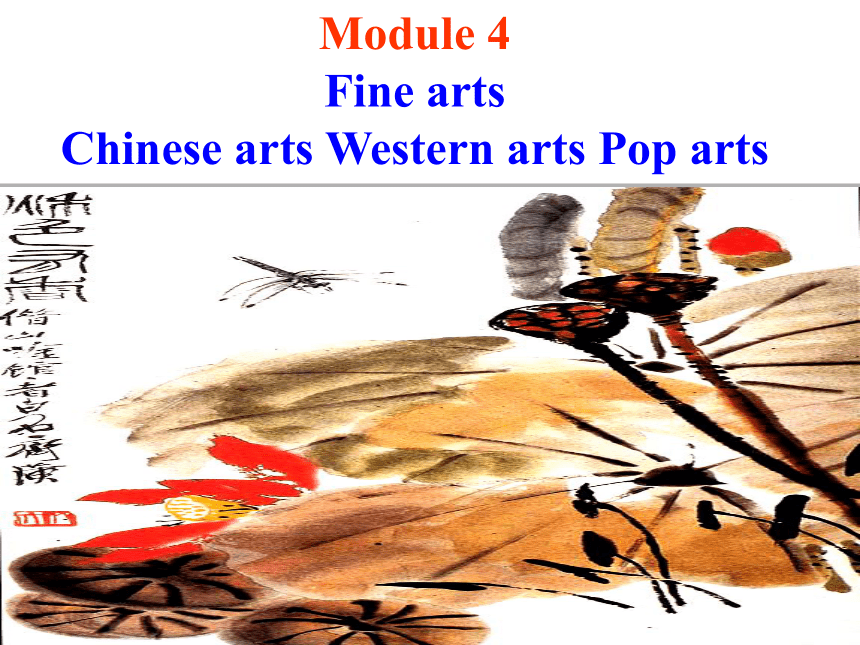 | |
| 格式 | rar | ||
| 文件大小 | 5.0MB | ||
| 资源类型 | 教案 | ||
| 版本资源 | 外研版 | ||
| 科目 | 英语 | ||
| 更新时间 | 2006-12-20 09:32:00 | ||
图片预览

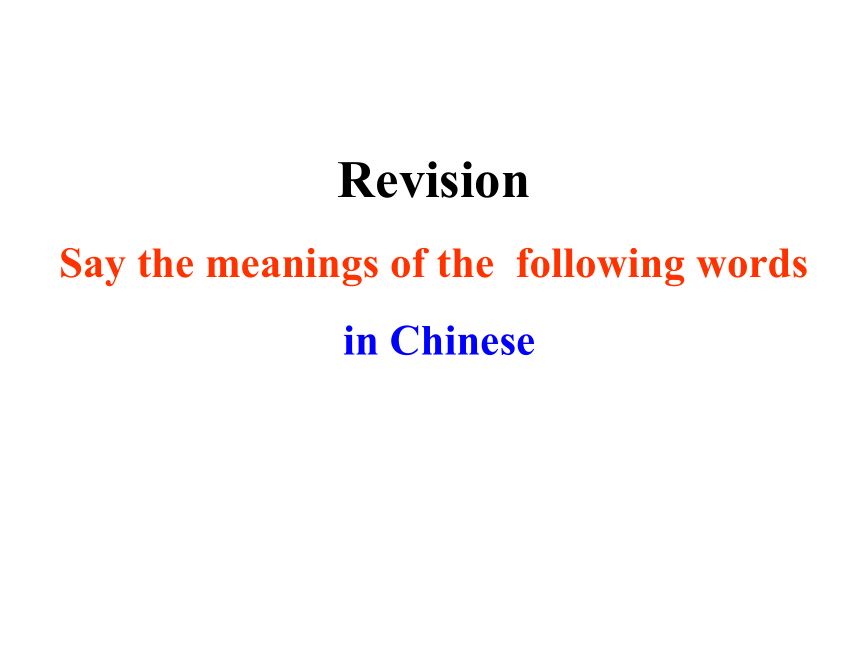
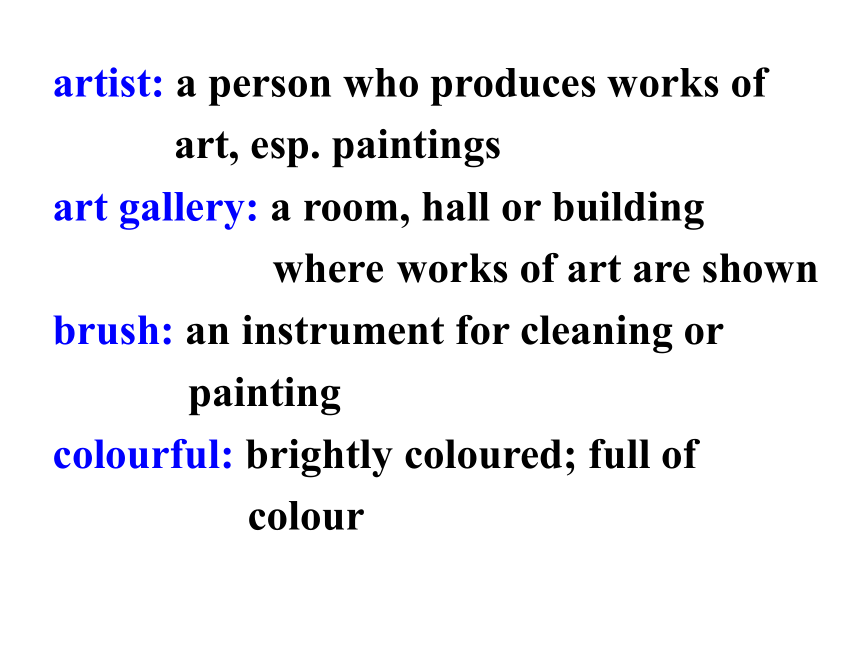
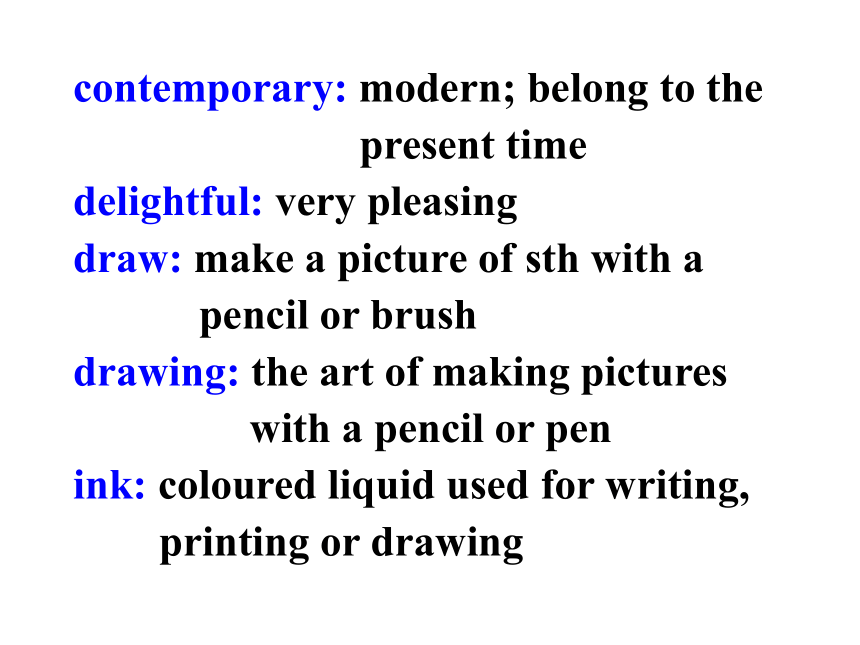
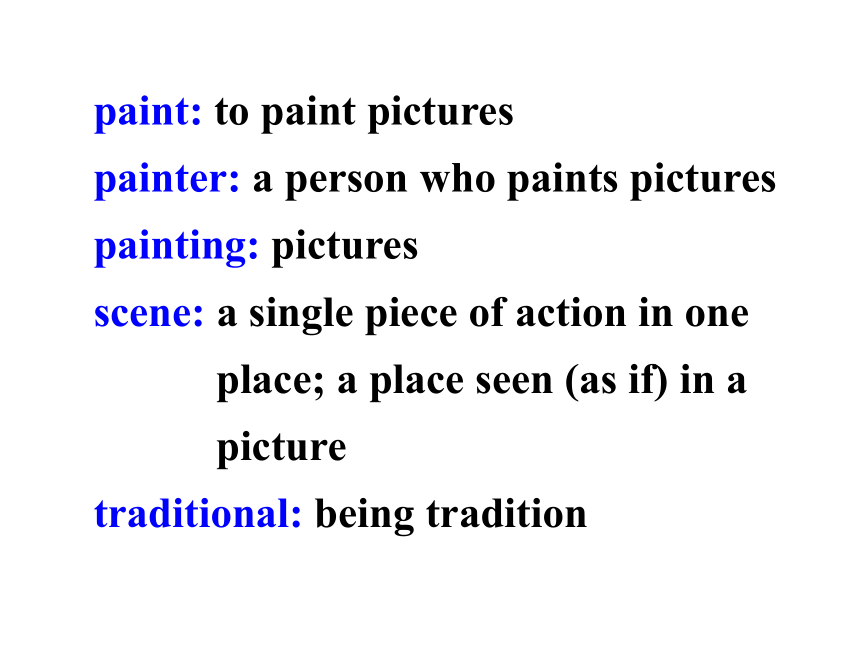
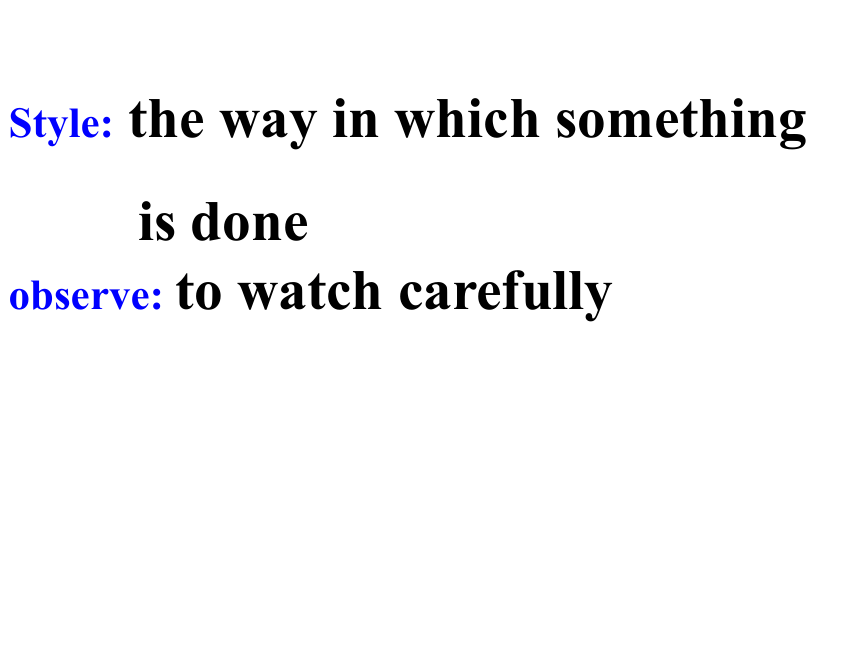
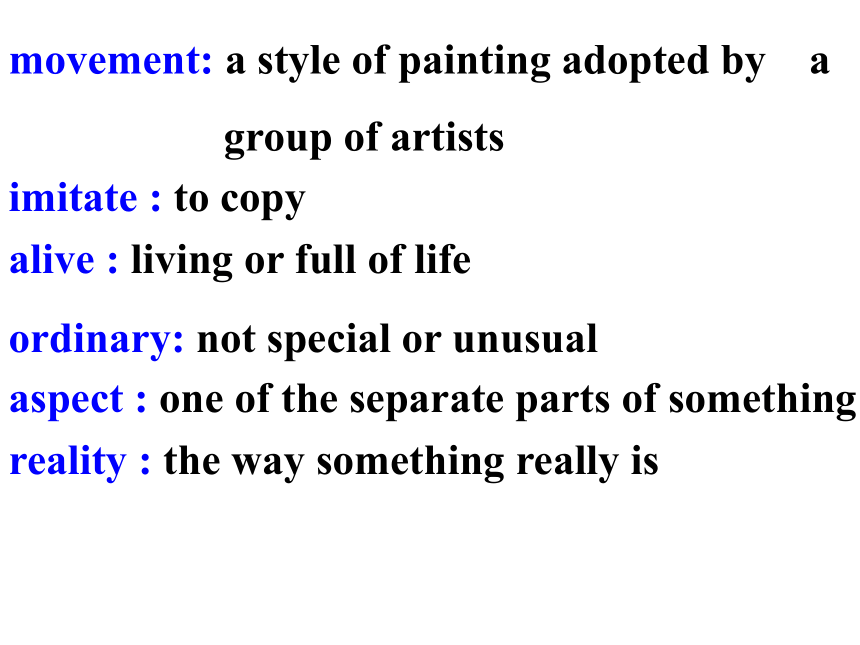
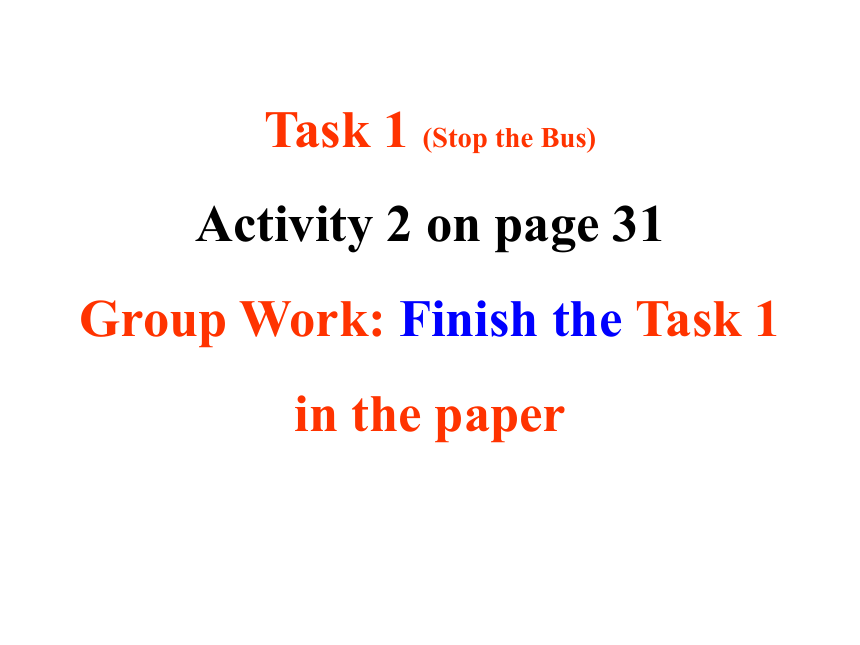
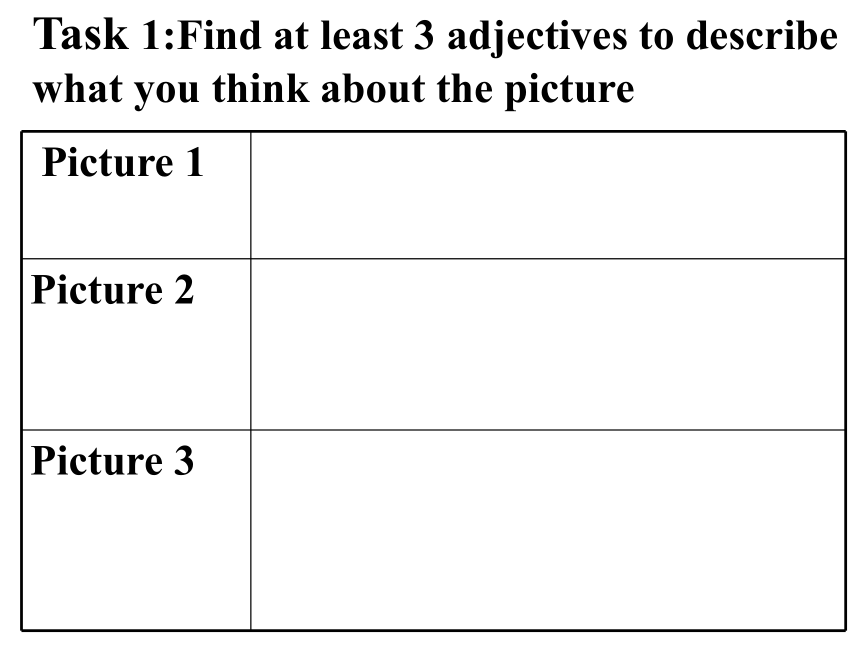
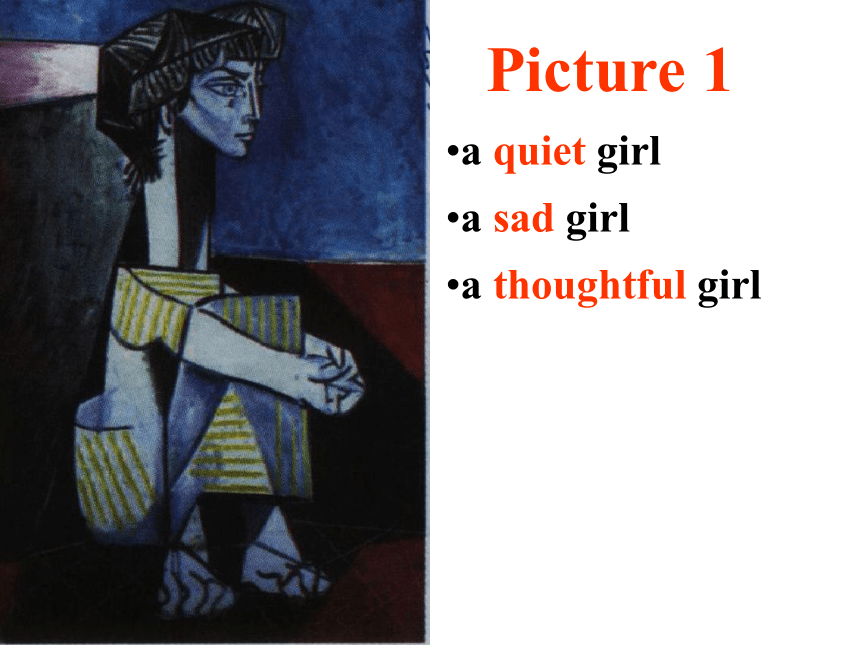
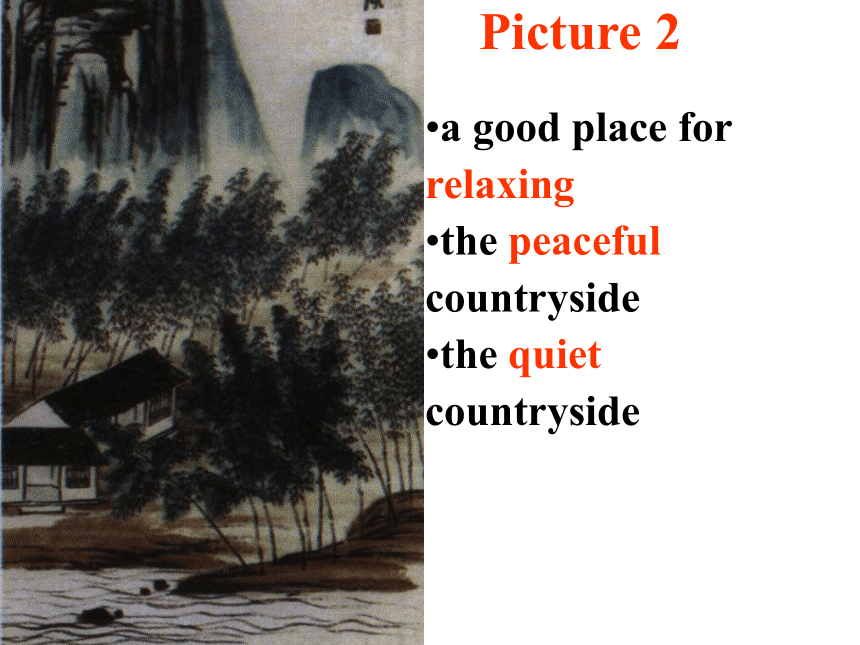
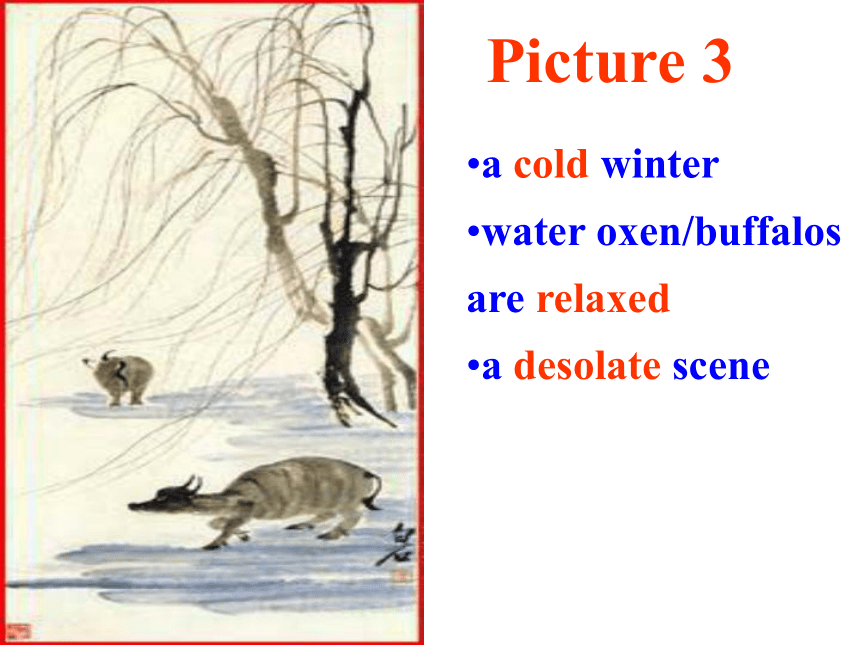
文档简介
课件45张PPT。Module 4
Fine arts
Chinese arts Western arts Pop artsRevision
Say the meanings of the following words
in Chineseartist: a person who produces works of art, esp. paintings
art gallery: a room, hall or building where works of art are shown
brush: an instrument for cleaning or painting
colourful: brightly coloured; full of colourcontemporary: modern; belong to the present time
delightful: very pleasing
draw: make a picture of sth with a pencil or brush
drawing: the art of making pictures with a pencil or pen
ink: coloured liquid used for writing, printing or drawingpaint: to paint pictures
painter: a person who paints pictures
painting: pictures
scene: a single piece of action in one place; a place seen (as if) in a picture
traditional: being traditionStyle: the way in which something
is done observe: to watch carefully
movement: a style of painting adopted by a
group of artists
imitate : to copy
alive : living or full of life
ordinary: not special or unusual
aspect : one of the separate parts of something
reality : the way something really is
Task 1 (Stop the Bus)
Activity 2 on page 31
Group Work: Finish the Task 1
in the paperTask 1:Find at least 3 adjectives to describe what you think about the picture?
?
Picture 1a quiet girl
a sad girl
a thoughtful girlPicture 2a good place for relaxing
the peaceful countryside
the quiet countrysidePicture 3a cold winter
water oxen/buffalos are relaxed
a desolate sceneFast Reading:
(Page 32) (1 minute)
Match paintings 1-4 with descriptions in Paragraphs A-D
on page 33Picture 1Paragraph C decribes the Picture 1, whose author is Qi BaishiQi BaishiQi BaishiQi Bai-shi was born in Xiangtan County, Hunan Province.
He was a woodcarver in his early youth, and taught himself painting, poetry, in his spare time. In the seven years beginning from 1902, he left home five times to wander around many famous mountains, lakes and rivers throughout the country and painted numerous landscapes. Qi BaishiQi BaishiIn 1954 he was a deputy of the First National People's Congress.
In 1955 he was awarded the World Peace Prize by the World Peace Council. Let’s talk about Picture 2Picture 2Paragraph A decribes the Picture 2, whose author is Pablo PicassoPablo PicassoPablo PicassoPablo Picasso was born in Spain. By the age of 15 he was already technically skilled in drawing and painting. In 1907 he and French painter George Braque pioneered cubism.Pablo PicassoLet’s talk about the
Picture 3Picture 3Paragraph D decribes the Picture 3, whose author is Xu BeihongXu BeihongXu BeihongXu Beihong influenced the development of 20th-century Chinese painting through his role as art teacher and administrator as well as his painting.Xu BeihongHe devoted himself to art and contributed a great deal to the reform of Chinese painting .
He excelled in both Chinese and Western art . Xu BeihongAfter his death in 1953, a Xu Beihong Museum was established at his home in Beijing.
Let’s talk about Picture 4Picture 4Paragraph B decribes the Picture 4, whose author is Roy LichtensteinRoy LichtensteinRoy Lichtenstein was born in New York City .
in his junior year he started to draw and paint as a hobbyRoy LichtensteinRoy LichtensteinIn his last year of high school, 1939, he enrolled for summer art classesIn 1960 Lichtenstein was appointed Assistant Professor at Douglas CollegeRoy LichtensteinPlease Listen to the Tape for the textPrepare the Chain Questions on Paragraphs A-F in Groups Task 2:
Detailed Reading
Read Paragraphs A--D
Fill in the form in paper in groups Span cubism with different aspectsAmerica pop art ordinary city life China brush observe carefully
drawing China brush showing reality
drawing Task 3:
Fill in the blanks in the paper
What do Wu Hang and Sarah Hardwich like and dislike?Qi Baishi Crazy a golden stupid
-haired
girlSix horses alivethe girl extraor-
dinary
artistTask 4:
Prepare a questionnaire about
people’s likes and dislikes in
art or something elseHome work:
Find more information on one of the artists mentioned today.Discussion: (in Groups)
Why do arts have different styles?
Fine arts
Chinese arts Western arts Pop artsRevision
Say the meanings of the following words
in Chineseartist: a person who produces works of art, esp. paintings
art gallery: a room, hall or building where works of art are shown
brush: an instrument for cleaning or painting
colourful: brightly coloured; full of colourcontemporary: modern; belong to the present time
delightful: very pleasing
draw: make a picture of sth with a pencil or brush
drawing: the art of making pictures with a pencil or pen
ink: coloured liquid used for writing, printing or drawingpaint: to paint pictures
painter: a person who paints pictures
painting: pictures
scene: a single piece of action in one place; a place seen (as if) in a picture
traditional: being traditionStyle: the way in which something
is done observe: to watch carefully
movement: a style of painting adopted by a
group of artists
imitate : to copy
alive : living or full of life
ordinary: not special or unusual
aspect : one of the separate parts of something
reality : the way something really is
Task 1 (Stop the Bus)
Activity 2 on page 31
Group Work: Finish the Task 1
in the paperTask 1:Find at least 3 adjectives to describe what you think about the picture?
?
Picture 1a quiet girl
a sad girl
a thoughtful girlPicture 2a good place for relaxing
the peaceful countryside
the quiet countrysidePicture 3a cold winter
water oxen/buffalos are relaxed
a desolate sceneFast Reading:
(Page 32) (1 minute)
Match paintings 1-4 with descriptions in Paragraphs A-D
on page 33Picture 1Paragraph C decribes the Picture 1, whose author is Qi BaishiQi BaishiQi BaishiQi Bai-shi was born in Xiangtan County, Hunan Province.
He was a woodcarver in his early youth, and taught himself painting, poetry, in his spare time. In the seven years beginning from 1902, he left home five times to wander around many famous mountains, lakes and rivers throughout the country and painted numerous landscapes. Qi BaishiQi BaishiIn 1954 he was a deputy of the First National People's Congress.
In 1955 he was awarded the World Peace Prize by the World Peace Council. Let’s talk about Picture 2Picture 2Paragraph A decribes the Picture 2, whose author is Pablo PicassoPablo PicassoPablo PicassoPablo Picasso was born in Spain. By the age of 15 he was already technically skilled in drawing and painting. In 1907 he and French painter George Braque pioneered cubism.Pablo PicassoLet’s talk about the
Picture 3Picture 3Paragraph D decribes the Picture 3, whose author is Xu BeihongXu BeihongXu BeihongXu Beihong influenced the development of 20th-century Chinese painting through his role as art teacher and administrator as well as his painting.Xu BeihongHe devoted himself to art and contributed a great deal to the reform of Chinese painting .
He excelled in both Chinese and Western art . Xu BeihongAfter his death in 1953, a Xu Beihong Museum was established at his home in Beijing.
Let’s talk about Picture 4Picture 4Paragraph B decribes the Picture 4, whose author is Roy LichtensteinRoy LichtensteinRoy Lichtenstein was born in New York City .
in his junior year he started to draw and paint as a hobbyRoy LichtensteinRoy LichtensteinIn his last year of high school, 1939, he enrolled for summer art classesIn 1960 Lichtenstein was appointed Assistant Professor at Douglas CollegeRoy LichtensteinPlease Listen to the Tape for the textPrepare the Chain Questions on Paragraphs A-F in Groups Task 2:
Detailed Reading
Read Paragraphs A--D
Fill in the form in paper in groups Span cubism with different aspectsAmerica pop art ordinary city life China brush observe carefully
drawing China brush showing reality
drawing Task 3:
Fill in the blanks in the paper
What do Wu Hang and Sarah Hardwich like and dislike?Qi Baishi Crazy a golden stupid
-haired
girlSix horses alivethe girl extraor-
dinary
artistTask 4:
Prepare a questionnaire about
people’s likes and dislikes in
art or something elseHome work:
Find more information on one of the artists mentioned today.Discussion: (in Groups)
Why do arts have different styles?
